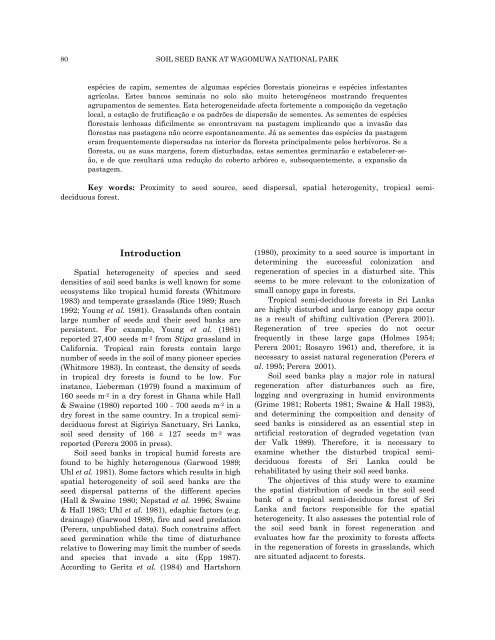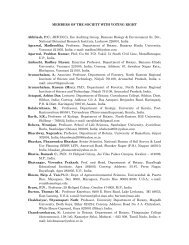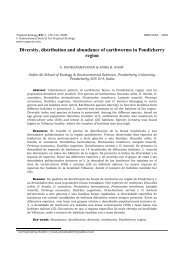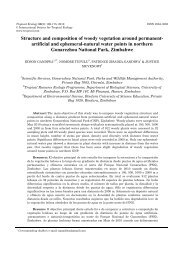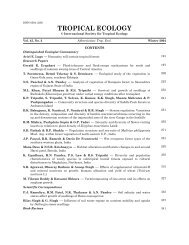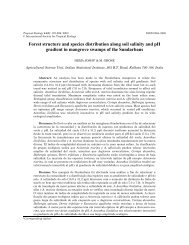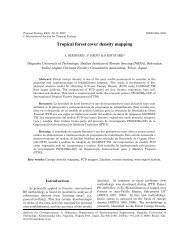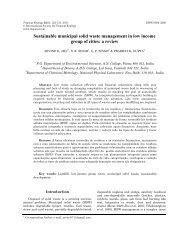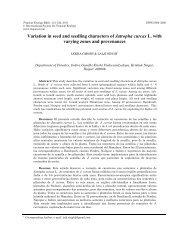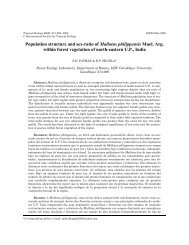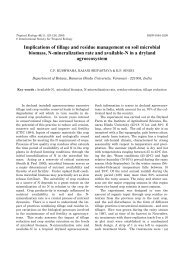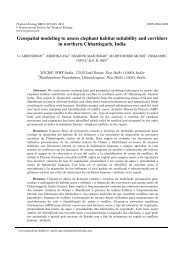Spatial heterogeneity of the soil seed bank in the tropical semi ...
Spatial heterogeneity of the soil seed bank in the tropical semi ...
Spatial heterogeneity of the soil seed bank in the tropical semi ...
You also want an ePaper? Increase the reach of your titles
YUMPU automatically turns print PDFs into web optimized ePapers that Google loves.
80 SOIL SEED BANK AT WAGOMUWA NATIONAL PARKespécies de capim, sementes de algumas espécies florestais pioneiras e espécies <strong>in</strong>festantesagrícolas. Estes bancos sem<strong>in</strong>ais no solo são muito heterogéneos mostrando frequentesagrupamentos de sementes. Esta heterogeneidade afecta fortemente a composição da vegetaçãolocal, a estação de frutificação e os padrões de dispersão de sementes. As sementes de espéciesflorestais lenhosas dificilmente se encontravam na pastagem implicando que a <strong>in</strong>vasão dasflorestas nas pastagens não ocorre espontaneamente. Já as sementes das espécies da pastagemeram frequentemente dispersadas na <strong>in</strong>terior da floresta pr<strong>in</strong>cipalmente pelos herbívoros. Se afloresta, ou as suas margens, forem disturbadas, estas sementes germ<strong>in</strong>arão e estabelecer-seão,e de que resultará uma redução do coberto arbóreo e, subsequentemente, a expansão dapastagem.Key words: Proximity to <strong>seed</strong> source, <strong>seed</strong> dispersal, spatial heterogenity, <strong>tropical</strong> <strong>semi</strong>deciduousforest.Introduction<strong>Spatial</strong> <strong>heterogeneity</strong> <strong>of</strong> species and <strong>seed</strong>densities <strong>of</strong> <strong>soil</strong> <strong>seed</strong> <strong>bank</strong>s is well known for someecosystems like <strong>tropical</strong> humid forests (Whitmore1983) and temperate grasslands (Rice 1989; Rusch1992; Young et al. 1981). Grasslands <strong>of</strong>ten conta<strong>in</strong>large number <strong>of</strong> <strong>seed</strong>s and <strong>the</strong>ir <strong>seed</strong> <strong>bank</strong>s arepersistent. For example, Young et al. (1981)reported 27,400 <strong>seed</strong>s m -2 from Stipa grassland <strong>in</strong>California. Tropical ra<strong>in</strong> forests conta<strong>in</strong> largenumber <strong>of</strong> <strong>seed</strong>s <strong>in</strong> <strong>the</strong> <strong>soil</strong> <strong>of</strong> many pioneer species(Whitmore 1983). In contrast, <strong>the</strong> density <strong>of</strong> <strong>seed</strong>s<strong>in</strong> <strong>tropical</strong> dry forests is found to be low. For<strong>in</strong>stance, Lieberman (1979) found a maximum <strong>of</strong>160 <strong>seed</strong>s m -2 <strong>in</strong> a dry forest <strong>in</strong> Ghana while Hall& Swa<strong>in</strong>e (1980) reported 100 - 700 <strong>seed</strong>s m -2 <strong>in</strong> adry forest <strong>in</strong> <strong>the</strong> same country. In a <strong>tropical</strong> <strong>semi</strong>deciduousforest at Sigiriya Sanctuary, Sri Lanka,<strong>soil</strong> <strong>seed</strong> density <strong>of</strong> 166 ± 127 <strong>seed</strong>s m -2 wasreported (Perera 2005 <strong>in</strong> press).Soil <strong>seed</strong> <strong>bank</strong>s <strong>in</strong> <strong>tropical</strong> humid forests arefound to be highly heterogenous (Garwood 1989;Uhl et al. 1981). Some factors which results <strong>in</strong> highspatial <strong>heterogeneity</strong> <strong>of</strong> <strong>soil</strong> <strong>seed</strong> <strong>bank</strong>s are <strong>the</strong><strong>seed</strong> dispersal patterns <strong>of</strong> <strong>the</strong> different species(Hall & Swa<strong>in</strong>e 1980; Nepstad et al. 1996; Swa<strong>in</strong>e& Hall 1983; Uhl et al. 1981), edaphic factors (e.g.dra<strong>in</strong>age) (Garwood 1989), fire and <strong>seed</strong> predation(Perera, unpublished data). Such constra<strong>in</strong>s affect<strong>seed</strong> germ<strong>in</strong>ation while <strong>the</strong> time <strong>of</strong> disturbancerelative to flower<strong>in</strong>g may limit <strong>the</strong> number <strong>of</strong> <strong>seed</strong>sand species that <strong>in</strong>vade a site (Epp 1987).Accord<strong>in</strong>g to Geritz et al. (1984) and Hartshorn(1980), proximity to a <strong>seed</strong> source is important <strong>in</strong>determ<strong>in</strong><strong>in</strong>g <strong>the</strong> successful colonization andregeneration <strong>of</strong> species <strong>in</strong> a disturbed site. Thisseems to be more relevant to <strong>the</strong> colonization <strong>of</strong>small canopy gaps <strong>in</strong> forests.Tropical <strong>semi</strong>-deciduous forests <strong>in</strong> Sri Lankaare highly disturbed and large canopy gaps occuras a result <strong>of</strong> shift<strong>in</strong>g cultivation (Perera 2001).Regeneration <strong>of</strong> tree species do not occurfrequently <strong>in</strong> <strong>the</strong>se large gaps (Holmes 1954;Perera 2001; Rosayro 1961) and, <strong>the</strong>refore, it isnecessary to assist natural regeneration (Perera etal. 1995; Perera 2001).Soil <strong>seed</strong> <strong>bank</strong>s play a major role <strong>in</strong> naturalregeneration after disturbances such as fire,logg<strong>in</strong>g and overgraz<strong>in</strong>g <strong>in</strong> humid environments(Grime 1981; Roberts 1981; Swa<strong>in</strong>e & Hall 1983),and determ<strong>in</strong><strong>in</strong>g <strong>the</strong> composition and density <strong>of</strong><strong>seed</strong> <strong>bank</strong>s is considered as an essential step <strong>in</strong>artificial restoration <strong>of</strong> degraded vegetation (vander Valk 1989). Therefore, it is necessary toexam<strong>in</strong>e whe<strong>the</strong>r <strong>the</strong> disturbed <strong>tropical</strong> <strong>semi</strong>deciduousforests <strong>of</strong> Sri Lanka could berehabilitated by us<strong>in</strong>g <strong>the</strong>ir <strong>soil</strong> <strong>seed</strong> <strong>bank</strong>s.The objectives <strong>of</strong> this study were to exam<strong>in</strong>e<strong>the</strong> spatial distribution <strong>of</strong> <strong>seed</strong>s <strong>in</strong> <strong>the</strong> <strong>soil</strong> <strong>seed</strong><strong>bank</strong> <strong>of</strong> a <strong>tropical</strong> <strong>semi</strong>-deciduous forest <strong>of</strong> SriLanka and factors responsible for <strong>the</strong> spatial<strong>heterogeneity</strong>. It also assesses <strong>the</strong> potential role <strong>of</strong><strong>the</strong> <strong>soil</strong> <strong>seed</strong> <strong>bank</strong> <strong>in</strong> forest regeneration andevaluates how far <strong>the</strong> proximity to forests affects<strong>in</strong> <strong>the</strong> regeneration <strong>of</strong> forests <strong>in</strong> grasslands, whichare situated adjacent to forests.


